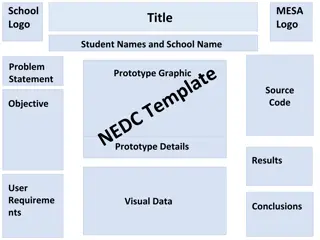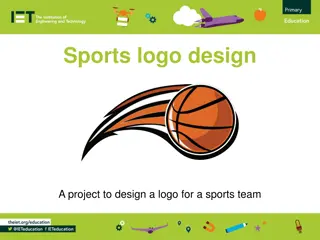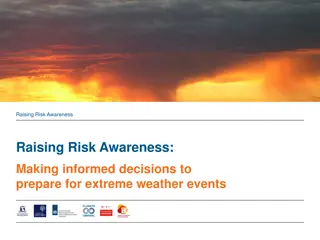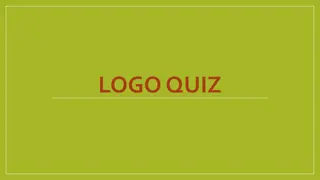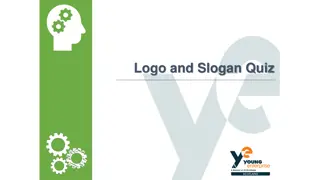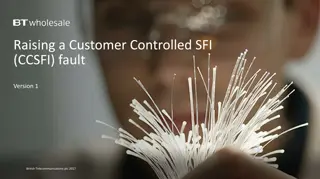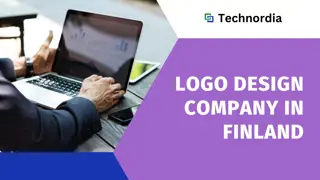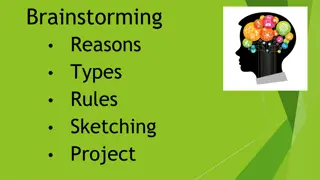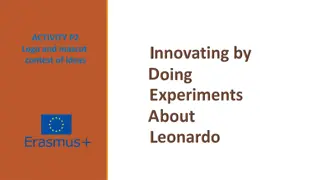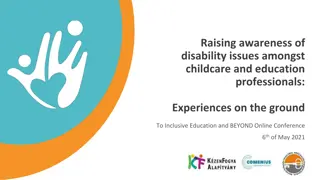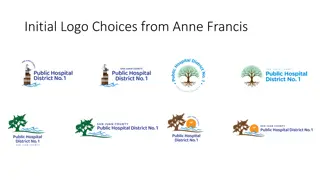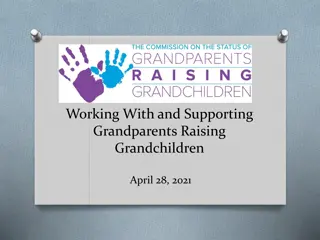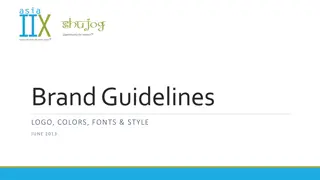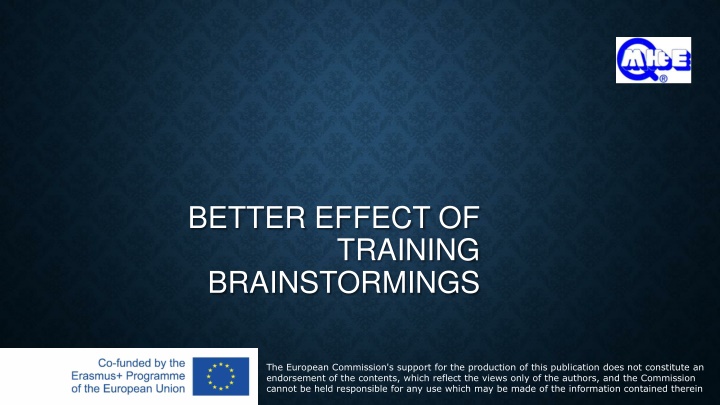
Effective Training Brainstormings for Inspector Course in Steel Structure Industries
Discover how a pilot inspector course in steel structure industries utilizes brainstorming sessions, discussions, and practical work-based activities to enhance knowledge and skills among participants. The course focuses on collaboration, industry partnerships, and achieving a common level of expertise.
Download Presentation

Please find below an Image/Link to download the presentation.
The content on the website is provided AS IS for your information and personal use only. It may not be sold, licensed, or shared on other websites without obtaining consent from the author. If you encounter any issues during the download, it is possible that the publisher has removed the file from their server.
You are allowed to download the files provided on this website for personal or commercial use, subject to the condition that they are used lawfully. All files are the property of their respective owners.
The content on the website is provided AS IS for your information and personal use only. It may not be sold, licensed, or shared on other websites without obtaining consent from the author.
E N D
Presentation Transcript
BETTER EFFECT OF TRAINING BRAINSTORMINGS The European Commission's support for the production of this publication does not constitute an endorsement of the contents, which reflect the views only of the authors, and the Commission cannot be held responsible for any use which may be made of the information contained therein
INTRODUCTION The course for inspector starts with collecting the students taking part in the course. The first session is to meet and know each other and the main tasks and aims of the course and the tools and special IT tools used during education. The next step is to be acquainted with the planned result which can be achieved during the inspector course. The whole education is in line to the daily practice of the students in their wok-place. The basic concept of pilot inspector course is that it is a pilot course, work-based learning method used and strong cooperation developed among the students, teachers, mentors and tutors. The pilot course provider has a very large number of economical and industrial organizations being in connection to the MHtE and the result is that they can delegate members to the pilot course for welding inspectors. One of this activity was to collect a team coming from different branches of steel structure industries and students should have the equal and shame level of knowledge and information on welding. The basic learning methods were that the teachers were ready for discussion which were developed among students and teachers as well.. The next pages of this report is dealing with the main characteristics of pilot course.
MEETINGS: Dates: 19.01.2021, 21.01.2021 Participants: Dr. G za Gremsperger, B la Gayer, J lia Benedek Method: Brainstorming Invited industrial firms: Contitech Rubber Industrial Kft. (A), Fortaco Zrt (B), Attest Kft, KER-SZER M rn kiroda Kft., HO-RA Kft. (C), Nitrog nm vek Zrt. (D), Siemens Zrt. (E), Gerecse-Plusz Kft., KK Industry Kft.(F), Optiber Kft. , F mszerkezet Kft. (G), Ganz Hungary G pgy rt Kft. (H), MCE Ny regyh za Kft.(J), TT Engineering M rn ki Iroda Kft. (K), QCH Anyagvizsg l Kft. (L), Corweld Plusz Kft., Crown International Kft., Messer Hungarogaz Kft., Rechen Hegeszt h z Kft. (M), G per Kft. (N), Taweld Kft. (O), Polyweld Kft. (P), Qualiweld Kft. , Poligrat Magyarorsz g Kft. (Q) Kft., M tra Diagnosztika
DISCUSSIONS After each lecture hours the teacher started discussion on results achieved during practical work-based activities. For this discussion there are prepared special questions according to the CU S. (competence unit - CU) it). The answers were are discussed and evaluated. The results are fixed in reports just connected to the given question. The aim of discussion was to achieve the mainstream level of knowledge which is the same for all pilot course participants.
Background information about the participating companies in the discussion
1. What type of production do you have? Serial production of a product or customized small scale production? Conclusion: 40% 35% 100 % customised small scale production 30% 25% 20% 15% 10% 5% 0%
INTRODUCTION TO THE MEETINGS: The meetings were organised on 19. and 21.01.2021. in two groups. The tool and the method was online brainstorming. The invitation and the questions were sent to twenty industrial firms two weeks before brainstorming meetings. Sixteen firms have been participated on the online meetings from twenty, it means 80% participating.
QUESTIONS DISCUSSED WITH THE PARTICIPANTS The conclusion of each question is summarized after the question
2. HAVE YOU DEFINED ANY ACCEPTABLE QUALITY LEVEL (AQL) FOR YOUR PRODUCTS ? Conclusion: Yes, today is not possible to sell any product without fulfilling of the requirements of EN ISO 1090, using ISO 2859-1.
3. HAVE YOU IMPLEMENTED AN INSPECTION LEVEL AT RECEIVING GOODS? Conclusion: Yes, 100 %, but comprehensive level has only two and specific and basic level 7-7 firms.
4. ARE YOU USING SUB-SUPPLIERS? Conclusion: 100 % always. But, in many cases the firms are sub- suplliers themselves. In EU the trade activity at the area of steelstructures and pressure vessels is very difficult, except if the owner of the product is from Germany generally. Only the designer is not using sub-supplier.
5. ARE THE SUB-SUPPLIERS RESPONSIBLE FOR THEIR OWN INSPECTION OR ARE YOU CARRYING OUT ANY INSPECTIONS AT THEIR SITE? Conclusion: The sub-suppliers always are responsible for their activity and fixed in their contract, but the firms inspect the activity of sub- suppliers or random or planned.
6. WHAT IS THE AQL FOR THE SUB- SUPPLIERS? Conclusion: It depends on the volume and subject of the contract between the firm and the sub- supplier. If the certification e.g EN ISO 1090 or EN 13445 these are beneficial to make the contarct. If not the task of the activity have the sub- suppliers by the contract. sub-supplier has
7. ARE YOU ALSO CARRYING OUT THE DESIGN OF THE PRODUCTS? Conclusion: The producers are not carrying out the design of the product. Generally or they get from the order the plans or is involved appropriate designer.
8. IF NO, HAS THE DESIGN BEEN EVALUATED FROM AN INSPECTION POINT OF VIEW? Conclusion: In all cases by the inspectors but many times the inspectors have less knowledge as the designer. It could be improved the process for teaching.
9. DO YOU HAVE YOUR OWN INSPECTION TEAM? Conclusion: The Hungarian firms don t know the term of the inspection team , but only the quality control unit. If the firms have certificate of EN ISO 3834-2 (there is true in 80%) belong to the welding coordination, if they have not, the employer appoints 1-1 person to make the inspection activity.
10. WHAT TYPE OF KNOWLEDGE AND CERTIFICATION DOES THE INSPECTION TEAM HAVE ? Conclusion: If the firms have certification according to EN ISO 3834-2, in 50% of cases the inspector has a diplom according to IAB 041 r4 or r5 of IIW. ( 80%) If there is not, the inspectors have to participate a generally training of quality managing by the leaders of the firm, so he/she works as trained worker at a basic level.
11. DO YOU OUTSOURCE THE INSPECTION TASKS OR SOME OF THE INSPECTION TASKS? Conclusion: It depends on the requirements of the product. Partly yes partly outsource.
12. DO YOU HAVE A MAINTENANCE AND CALIBRATION PLAN FOR INSPECTION EQUIPMENT? Conclusion: Yes, it is, each firm has ISO 9001 certification so in 100 % yes the answer.
13. WHAT TYPE OF INSPECTION EQUIPMENT DO YOU HAVE? Conclusion: The answers were representatives mixed the two terms what is the difference between the inspection. That is why some representatives have been listed all testing equipment, not the inspection tools. 70 % knew -30 % not very interesting. Some testing and and
14. DO YOU HAVE A DOCUMENT MANAGEMENT SYSTEM FOR THE INSPECTION AND INSPECTION REPORTS? Conclusion: In Hungary used the firm of Quality plan according to ISO 9001 and the content depends on the product. requirements of the 50 % yes- 50 % not.
15. DO YOU HAVE FULL TRACEABILITY OF ALL REPORTS? Conclusion: Mandatory 100 %.
16. WHAT IS THE INSPECTION COSTS? Conclusion: Nobody knows, neither the inspection cost, nor the testing cost .
17. WHAT IS THE REPAIR COSTS IN THE COMPANY? Conclusion: No data
18. AT WHAT STAGE IN PRODUCTION DO YOU FIND REPAIR AND INSPECTION ACTIVITY? Conclusion: There is inspection activity in whole pocess before, during and after the welding. There is repair cost if the welded product is not approprite to the requirements.
19. WHAT IS THE REPAIR RATE AFTER DELIVERY OF THE PRODUCT? Conclusion: No info
20. HOW DO YOU CARRY OUT CORRECTIVE ACTIONS AFTER A REPAIR? Conclusion: By the ISO 9001, ISO 3834 but many times the activity is very urgent and there is not appropriate to the ISO 9001 s steps.
21. THE INDIVIDUALS YOU ARE USING FOR INSPECTION. WHAT TYPE OF FORMAL EDUCATION DO THEY HAVE? Conclusion: There is no formal education for welding inspection.
22. GIVES THE FORMAL EDUCATION SUFFICIENT BACKGROUND FOR CARRYING OUT THE INSPECTION WORK THEY ARE DOING? Conclusion: See clause 21 But, the education depends on the management of the firm. Where there is ISO 9001 there is training plan. But generally where there is no ISO system there is no any education. Only employed inspectors if they have at least 5 years experience at his/her tasks.
23. IF NO, THEN WHAT KIND OF ADDITIONAL EDUCATION DO THESE PEOPLE GET? Conclusion: There is needed individual national or international sources, using internet but there is needed a n annual evaluation of the inspectors and regulation how and when and what is needed for the inspectors to have more knowledge and competence. training , to find the firm s management
24. DO YOU HAVE A FORMAL/INFORMAL ON- THE -JOB TRAINING SCHEME? Conclusion: There is no internal scheme generally 80 % and it depends on the management of the firm, but there is informal training scheme by the EWF-IAB 041 guideline.
25. IF YES WHY DO YOU FEEL THAT THIS IS REQUIRED? Conclusion: If the inspection of product is not appropriate to the requirement, because the inspectors have competences, the product can be not sold. not appropriate
26. IF YOUR PERSONNEL NEED ADDITIONAL TRAINING, HOW DO YOU PREFER THAT THIS TRAINING IS CARRIED OUT? 27. WOULD SUCH TRAINING BE NEEDED ON A REGULAR BASIS? 28. WOULD YOU CARRY OUT SUCH TRAINING BY YOURSELF OR WOULD YOU PREFER TO GET SUCH TRAINING BY OUTSIDE SOURCES? From 26 to 28 - See clause 23.
29. WHAT EQF LEVEL OF COURSE SHOULD BE? No national EQF level only at the international education EWI-B Level 4 EWI-S Level 5 EWI-C Level 6 should be for inspectors.
30. WHAT DO YOU EXPECT AS LEARNING OUTCOMES?....... See the document IAB 041
31. SHOULD BE LECTURES BASED ON THE STANDARDS OF THE SERIES EN ISO 15614 AND THE VARIOUS DIRECTIVES, ISO 9001, EN 1090 OR EN 3834? All nominated standards yes, but depends on the product and the regulation.
32. COMPOSITION OF THE COURSE THEORY : PRACTICE? Yes by the guideline IAB 041 (70% theory, 30% practice)
33. HOW MANY COURSE MODULES (CHOICE BETWEEN 1. THEORY OF JOINING PROCESS, QUALITY SYSTEMS, INSPECTION PROCESSES, ) THEY WOULD LIKE AND RELATION BETWEEN THEM?........ By the guideline there is welding technology module and separated inspection module and practical module. But, the true training time schedule and content of the knowledge depends on the recognized prior learning of the candidates.
34. WHAT WE SHOULD HARMONIZE EUROPEAN WIDE: RESULTS OF EXAMS, LOS, WORKING LOAD HOURS? The best way using the IAB 041 guideline . After the teaching there is a practical and theoretical exam.
35. WHAT EXACTLY IS RECOMMENDED FOR LEARNING BY DOING PROCESS? There learning by doing process e.g face to face or work based learning system, using internet, videoconference. It possibilities of the training methods and tools and using all developed possibilities. are many tools recommended to means using all educational
36. WHAT FUNCTION AND TASKS SHALL THE INSPECTOR COVER? Discover all mistake before, during and after the welding. Inspect the final docs. proposals how can be improved the steps of the product producing at the efficiency, time schedule, quality assurance areas. Do make
THANK YOU FOR YOUR ATTENTION The European Commission's support for the production of this publication does not constitute an endorsement of the contents, which reflect the views only of the authors, and the Commission cannot be held responsible for any use which may be made of the information contained therein

